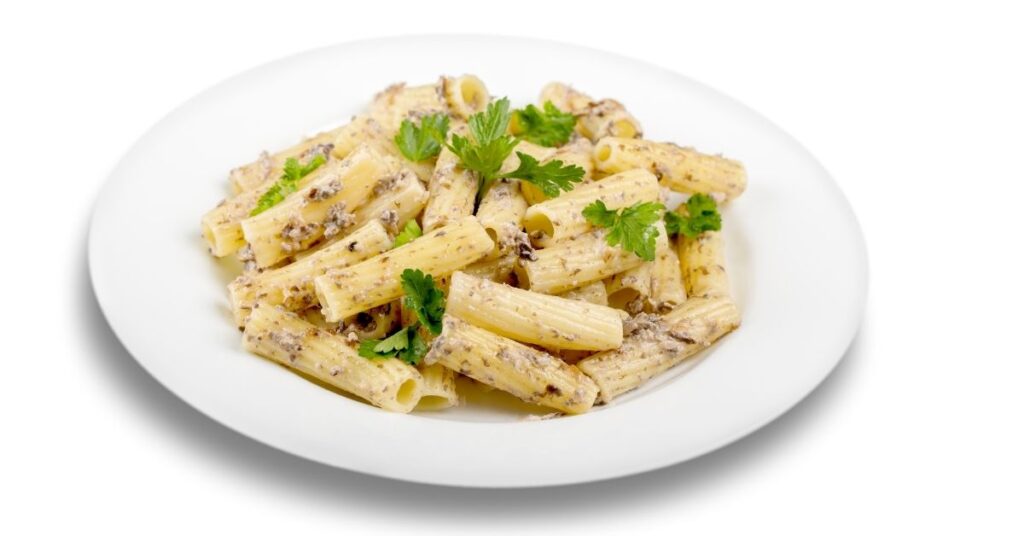Both pasta & rice can be healthy choices. Opt for whole-grain options, mindful portions, and varied toppings for balanced meals.
Is Pasta Healthier Than Rice?
Let’s cut to the chase–there’s no simple, one-size-fits-all answer when comparing pasta and rice. Both have their advantages and disadvantages. To decide which is “healthier,” we need to dive a little deeper. Let’s unravel this carb conundrum together!
What Defines “Healthy”?
Before we compare these starchy staples, what qualities make a food “healthy”? Here are some key things to consider:
- Macronutrients: The big three – carbs, protein, and fat. All are essential, but the balance matters.
- Micronutrients: Vitamins and minerals our bodies need in smaller amounts for optimal function.
- Fiber: The indigestible part of plant foods that keeps our gut healthy and happy.
- Glycemic Index (GI): A measure of how quickly a food raises our blood sugar levels.
Nutrition Showdown: Pasta vs. Rice
Let’s break down the key nutritional differences between pasta and rice. To keep things fair, we’ll compare similar serving sizes (1 cup cooked):
Table 1: Basic Nutrition Comparison
| Nutrient | White Rice | White Pasta | Whole Wheat Pasta |
| Calories | 242 | 221 | 174 |
| Carbs (g) | 53 | 47 | 37 |
| Protein (g) | 4 | 8 | 7 |
| Fiber (g) | 0.6 | 2.5 | 6 |
Notice how whole wheat pasta pulls ahead in fiber and offers a slight protein boost.
Digging into the Details
Carbohydrates
Both pasta and rice are mainly carbs, our body’s primary energy source. But the quality of those carbs has a big impact.
- Refined vs. Whole-Grain: Refined grains like white rice and pasta undergo processing that strips away fiber and micronutrients. Whole-grain versions retain valuable nutrients and fiber.
- Glycemic Index: Refined grains tend to have a higher GI, causing blood sugar spikes. Whole grains have a lower GI, meaning steadier blood sugar levels and longer-lasting energy.
Protein
When it comes to protein, pasta (especially whole wheat) holds a slight edge. Protein keeps us feeling satisfied and helps build and repair body tissues.
Fiber
Fiber is where whole grains really shine! Fiber benefits include:
- Improved digestion and gut health
- Lower cholesterol levels
- Better blood sugar control
- Reduced risk of chronic diseases like heart disease and type 2 diabetes
Micronutrients
Whole grains are naturally richer in B vitamins, iron, magnesium, and other essential micronutrients. Refined grains often have some of these nutrients added back during processing (enriched), but it doesn’t fully make up for what’s lost.
Beyond the Basics
Variety Matters
Just like there’s white and brown rice, the pasta world has expanded too:
- Legume-based pasta: Made with lentils, chickpeas, and beans, packing more protein and fiber.
- Gluten-free alternatives: Options made with brown rice, quinoa, or other grains are available.
These offer variety and can be especially beneficial for individuals with dietary needs or preferences.
Preparation is Key
How you prepare your pasta or rice can seriously impact its overall healthfulness. Here are some things to keep in mind:
- Portion control: Even healthy foods can become unhealthy when eaten in excess. Stick to recommended serving sizes.
- Sauces and toppings: Watch out for the calorie, fat, and sodium traps hidden in sauces. Opt for tomato-based, veggie-packed sauces, or make your own healthier versions. Choose lean protein toppings and go for generous portions of veggies.
- Cooking methods: Overcooked pasta and rice can become mushy and have a higher glycemic index. Aim for that al dente texture in pasta and fluffy, well-separated rice grains.
Special Considerations
- Gluten sensitivity: For those with celiac disease or gluten intolerance, rice is the clear winner. However, there are plenty of delicious gluten-free pasta products.
- Blood sugar concerns: Individuals with diabetes or those monitoring their blood sugar need to be mindful of portion size and choose whole grains whenever possible, as they are less likely to cause spikes.
- Athlete’s fuel: Both pasta and rice are suitable carb sources for athletes, but the timing and type can make a difference. Consult a sports dietitian for personalized guidance.
Lifestyle Factors
There’s more to health than just the food on your plate. Here’s how your overall lifestyle habits interact with your pasta and rice choices:
- Activity level: Highly active people need more carbohydrates to fuel their workouts, so either pasta or rice can work well. If you’re less active, moderation is key.
- Dietary patterns: Rather than focusing on a single food, look at the big picture. Are you eating plenty of fruits, vegetables, and lean protein sources alongside your starches? That’s what truly determines overall health.
Table 2: Advantages and Disadvantages
Let’s sum things up with this handy table of the pros and cons of both pasta and rice:
| Pasta | Rice | |
| Advantages | Versatile, good protein source (especially whole wheat), range of types available | Naturally gluten-free, can be fortified with vitamins and minerals |
| Disadvantages | Can be high in refined carbs (white varieties), gluten content in traditional pasta | Can be high in refined carbs (white rice), less fiber than whole grains |
Table 3: Making Healthier Choices
No matter which you choose, here are some tips for healthier versions of both:
- Choose whole-grain: Whenever possible, go whole-grain for more fiber, nutrients, and a lower glycemic index.
- Control portions: Keep servings in check to avoid overconsumption of calories.
- Focus on toppings: Pile on the veggies and lean proteins, and go easy on heavy sauces.
- Experiment: Try alternative types like chickpea pasta or brown rice for variety and added nutrients.
Conclusion- Is Pasta Healthier Than Rice?
So, is pasta healthier than rice? The truth is, there’s no clear-cut winner. Both can be part of a healthy eating pattern. The key is focusing on whole-grain varieties, practicing healthy preparation techniques, and considering your individual needs and preferences.
